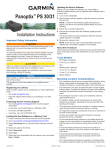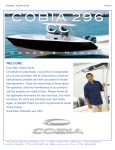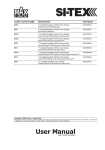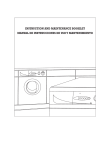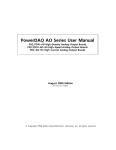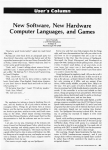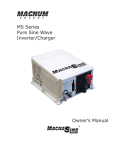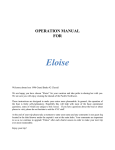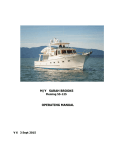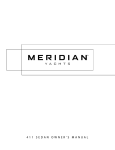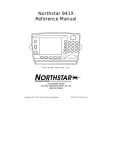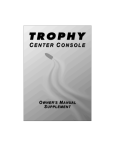Download SHIBUI - Anacortes Yacht Charters
Transcript
SHIBUI OCEAN ALEXANDER 50’ PILOTHOUSE MARK I OPERATIONS MANUAL Revision 9 – 08-08-2010 Contents Boat Operation ................................................................................................. 1 A. B. C. D. E. F. G. H. I. J. K. Engine Room Checks.................................................................................1 Shore-To-Boat Power Switching.................................................................1 Electronic Engine Controls .........................................................................2 Engine Starting ...........................................................................................3 Navigation Instruments...............................................................................4 Auto Pilot ....................................................................................................5 Anchoring ...................................................................................................6 Tender Launching, Use, And Loading ........................................................9 Toilets And Holding Tank .........................................................................12 Filling Diesel Tanks ..................................................................................13 Filling And Switching Water Tanks ...........................................................15 Electrical ........................................................................................................ 17 A. B. C. D. E. F. 110 Volt AC Systems................................................................................17 12 Volt DC Systems .................................................................................18 Magnum MS2812 Inverter ........................................................................19 Northern Light (NL) Generator Set (5.0 KW) ............................................20 Anchor Windlass.......................................................................................22 Roskelley/Olsson Davit.............................................................................22 Engine Room ................................................................................................. 25 A. B. C. D. E. F. G. H. Blowers.....................................................................................................25 Main Engines............................................................................................25 Starting & Stopping - See “Engine Starting” above...................................25 RACOR Primary Fuel Filters.....................................................................26 Raw Water Pump .....................................................................................26 Potable Water Pump ................................................................................27 Hot Water Heater......................................................................................27 Bilge Pumps .............................................................................................27 Galley, Head & Heat ...................................................................................... 29 A. B. C. D. E. F. G. H. I. J. K. L. Clothes Washer ........................................................................................29 Clothes Dryer............................................................................................29 Deck Freezer ............................................................................................30 Range.......................................................................................................30 Microwave ................................................................................................30 Refrigerator...............................................................................................31 Ice Maker..................................................................................................31 Electric Heaters ........................................................................................32 Everhot Hot Water Heater ........................................................................32 Webasto 2020 Hot Water Heating System ...............................................32 VacuFlush Heads .....................................................................................33 Groco, Thermopure 2 ...............................................................................33 Wheelhouse ................................................................................................... 35 A. B. C. D. Automatic Pilot..........................................................................................35 Engine Controls ........................................................................................35 Primary VHF Marine Radio.......................................................................35 Secondary VHF Marine Radio ..................................................................36 E. F. G. H. I. J. K. L. M. N. O. Digital Depth Sounder ..............................................................................37 Video Depth Finder...................................................................................37 Primary Radar ..........................................................................................38 Secondary Radar......................................................................................39 GPS..........................................................................................................39 Navigation PC...........................................................................................40 Buell Air Horn ...........................................................................................41 AM/FM Radio & Cassette .........................................................................41 Sony CD Changer ....................................................................................42 Spotlight ...................................................................................................42 Tachometer ..............................................................................................42 BOAT OPERATION A. ENGINE ROOM CHECKS Before each day’s cruise, the following engine room checks should be performed: 1. Check the oil and coolant levels in both Lehman diesels and add as necessary. 2. If the gen-set was used, check its oil and coolant and add as necessary. 3. Examine the sea strainers for the Lehmans and the gen-set and clean if needed. Be sure to leave through hull open when task is completed. 4. Visually check around the engine room for any water, oil, or fuel leaks. Identify the reason why and fix if found. 5. Check fuel level of the fuel tanks in use (open all three valves for each tank). B. SHORE-TO-BOAT POWER SWITCHING Departing from a dock with shore power connected you most commonly will want to switch the 110VAC load to the inverter instead of starting the gen-set. To switch from shore power to boat inverter power, perform the following steps: 1. Turn the AC selector switch near the steering wheel to the “OFF” position. 2. Observe the “PWR” LED on the Magnum inverter monitor (located to Port of the helm) and verify it is lit. If it is not lit, press the “INVERTER” button once to enable the inverter function. 3. Observe the “INV” LED and the LCD display on the Magnum inverter monitor. If AC power is being consumed, the LED will be solid green and the display will read “Inverting”. If no AC power is being consumed, the LED will be blinking green and the display will read “Searching”. 4. Inverted 110VAC is now available to all CB in the lowest row of CBs. Flip ON any or all of these CBs as needed. The CBs in the next to the lowest row cannot be powered by the inverter (shore power or gen-set power only). 5. Disconnect the shore power cord and stow. 1 6. The AC voltmeter and amp meter in the pilothouse CB panel does not show inverted power (shore power and gen-set power only). 7. The Magnum MS2812 inverter can produce about 25 amps of 110VAC power, but not for long due to battery capacity of 1200Ah (25A @ 110VAC = 300A @ 12VDC). 8. If 110VAC is not available on any inverter supplied circuits but the function is enabled (see step 3), the CB on the inverter may have been tripped and needs to be reset. To reset the CB, simply press the button (the inverter is in the lazaret to starboard). Note that the inverter does not produce 110VAC before an actual load is applied. To change from gen-set power to inverter power do the same as above except step #5. To change from inverter power to shore or gen-set power follow the same sequence except in #2 select SHORE or GEN as applicable. Prior to selecting SHORE on the AC selector switch the correct sized shore power cord (30A or 50A) must be hooked up to their correct sized receptacles at both ends, and the correct main CB (30A or 50A) must be selected. These two CBs for incoming shore power are located below the AC selector switch. Prior to selecting GEN on the AC selector switch the gen-set must be running and allowed to warm up (2-3 minutes). The voltmeter will now read 110VAC and the ammeter will show the amp draw. Both rows of CB will be connected, but remember that to get power to any of the CBs in the lowest row the CB marked INV must be ON. C. ELECTRONIC ENGINE CONTROLS SHIBUI is equipped with Glendinning electronic engine controls. Please review the excerpt of its operations guide located in the appendix to this manual to familiarize yourself with the operation of these controls. They are very intuitive, but there are some details of which you should be aware. Some key points: 1. Presently SHIBUI is not equipped with a second control station. Transfer of control between multiple stations is therefore not applicable. 2. TROLL mode is not applicable for SHIBUI as the transmissions have no trolling valve; selection of TROLL mode has no affect. 2 3. The circuit breaker powering the engine ignition also powers a relay that turns on the electronic engine controls. If that breaker trips or is accidentally turned off, the electronic engine controls will deactivate and the engines and transmissions will remain in the last commanded mode (e.g. neutral idle, forward gear with throttle, etc). Turning the breaker back on will in turn reactive the controls, which will then move to a setting of neutral idle. Operation may then continue as normal. 4. The electronic engine controls have redundant power supplies; all four circuit breakers (two for each engine) are in the port subpanel in the engine room and should be left on at all times. 5. The system will start up with WARM mode activated; this locks the gear in neutral while allowing throttle operation (for example, to ease starting or set a higher throttle position during engine warm up). D. ENGINE STARTING 1. Turn on the following circuit breakers (all 12VDC) in the center and upper portion of the pilothouse circuit breaker panel. ENGINES ENG BLOWER PANEL HORN 2. ignition power for engines, engine controls, engine gauges and windlass remote control blower for engine room engine instrument lights in the dashboard air horn control relay Turn on the following 110VAC circuit breaker in the lower portion of the pilothouse circuit breaker panel. AIR HORN COMPRESSOR air compressor for air horn 3. If the gen-set is running, ensure the charging function of the inverter is disabled. The Magnum control panel should read “Charger Standby” and the CHG LED slowly blinking. Press the CHARGER button to disable the charger if necessary. 4. Ensure both control levers are in their “neutral indent” position (if not, that engine will not start). 5. Ensure controls are in “WARM” mode (WARM LED steady red); if not, press the “WARM” button to engage mode. 6. Turn the starboard ignition key on. The red warning light and warning buzzer will come on. 3 7. Press the “START” button to engage the starter (no more than 10 seconds at a time). As soon as the engine starts, release the start button. 8. The control lever may be moved forward while in WARM mode which will advance the throttle for easier starting and engine warm up while remaining in neutral gear. 9. Adjust the starboard control lever to obtain 800-1000 RPM on the starboard tachometer. 10. Observe that the reading of the starboard oil gauge increases to above 20 psi at which time the warning light and buzzer shuts off. 11. Repeat steps 5 through 9 for the port engine 12. Allow the engines to warm up (observing temperature gauges) before departing. 13. When ready to depart, return control levers to neutral idle detent and press the WARM button to exit WARM mode. The WARM LED will go out and the transmission will shift with lever movement. E. NAVIGATION INSTRUMENTS Turn on and adjust the following instruments as needed. Operation instructions for each is included in the “Wheelhouse” portion of this document. Required circuit breakers are as follows: OVERHEAD FISH FINDER RADAR1 RADAR2 NAV AUTOPILOT Power for the radios and overhead instruments, including spotlight Power for the video fish finder/depth sounder Power for the primary radar (Furuno) Power for the secondary radar (Raytheon) Power for the GPS and PC navigation system Power for the autopilot a. Autopilot / rudder indicator b. Primary VHF marine radio set to channel 16; To verify operation check weather report c. Datamarine depth finder d. GPS e. PC Navigation system (if desired) f. Fish finder / depth sounder (if desired) g. Primary radar (if desired) h. Second VHF radio set to working frequency 4 F. AUTO PILOT To turn on and engage 1. Turn on the CB marked ‘autopilot’. 2. Press the STBY/PWR button and release. The system will go through an initialization routine. After approximately 5 seconds the system will be operative and in a STANDBY mode showing a rudder position indicator. 3. Steer the vessel to the desired course and hold the heading steady. 4. Press the AUTO button. The system will enter ‘auto’ mode and maintain the current course and a rudder position indicator. To disengage or turn off 1. Regain manual steering by pressing the STBY button. 2. To power off the unit, press and hold the STBY button for 2-3 seconds. During this time an alarm will sound. Course changing 1. Accomplished by turning the Course knob to select the new desired course. One revolution of the knob equals a 45° course change. Alternatively, the PORT or STARBOARD keys may be pressed to enter a new heading. 5 2. An alternate method of changing course is to disengage the auto pilot by pushing the STBY button. Hand steer the vessel to the new course and steady up on the new heading. Once on a steady heading, press the AUTO button to re-enter auto mode. Dodging 1. Dodging other vessels or objects can be performed without disengaging the auto pilot. This is accomplished by pressing the TURN/DODGE button twice while in auto mode. 2. The display will flash DODGE, and the boat must be handsteered as desired. 3. Once the obstacle has been passed, the original heading can be resumed by pressing the TURN/DODGE button once. If the current heading is desired to become the new heading (rather than the original heading), press the AUTO button to exit DODGE mode and maintain the current heading. G. ANCHORING To activate the windlass the main engines must be running, the generator must be running (with GEN selected on the AC selector switch) and the “WINDLASS” circuit breaker must be on. SHIBUI is equipped with 600 feet of 5/16 HT all chain rode. The chain is marked by small ropes tied to a link as follows: Marking of the Chain 1. One small rope every 5 fathoms = 30ft = 10m 2. Every second marking is replaced with two small ropes with several links between them (every 10 fathoms = 60ft = 20m). The number of links between the two ropes indicates quantities of 10 fathom increments ie.: 3 links = 30 fathoms (180ft, 60m), 5 links = 50 fathoms (300ft, 100m) To Drop Anchor 1. Select a suitable anchoring site that is protected and has a good holding bottom. Avoid rocky areas as the anchor may become lodged and be irretrievable. 2. Select a depth that will be deep enough through the tide swing and an adequate scope to hold the anchor from dragging at high tide (3:1 – 5:1 depending on conditions). 3. Decide if you want to use the windlass motor or the windlass wildcat to lower the anchor. 6 4. If you chose to use the windlass motor (110VAC): 5. a. Start the gen-set as described in the section on gen-set operating instructions. b. Switch the AC selector switch near the steering wheel to the “GEN” position. c. Put the “W/L” circuit breaker in the lower portion of the pilothouse panel in the up (on) position. d. Plug in the windlass remote on the bow; the receptacle is located on the starboard bulwark between the forward hawse hole and the salt water wash down faucet. Note that the windlass control is powered by the “ENGINES” circuit breaker. e. Stop the boat at the desired anchor location. f. Push the windlass remote toggle switch to the “DOWN (OUT)” position to power the windlass and begin lowering the anchor. g. Ease the anchor over the bow roller if necessary to get it started. h. After the anchor is on the bottom, let out adequate chain to achieve part of the desired scope. i. Back the boat slowly to take up the slack in the chain. Let out additional chain to gain proper scope. j. Apply mild tension to the anchor by gently backing up to verify the anchor is holding adequately. k. Observe over time that the anchor is holding by noting the boat’s position. If you chose to use the windlass wildcat: a. Stop the boat at the desired anchor location. b. Release the friction tension on the wildcat by turning the release wheel in a counter-clockwise direction. c. It may be necessary to step hard on the chain between the windlass and the anchor to “break” the initial friction. d. Control or stop the speed of the outgoing chain by turning the release wheel in the clockwise direction. If no effort is made to control the speed, the payout can become very fast and possibly dangerous. e. Let out adequate chain to achieve part of the desired scope. 7 f. Back the boat slowly to take up the slack in the chain. Let out additional chain to gain proper scope. g. Apply mild tension on the anchor by gently backing up to verify the anchor is holding adequately (depends on the weather).. h. Observe over time that the anchor is holding by noting the boat’s position. To Secure the Anchor: 1. Relieve the strain on the windlass by attaching both port and starboard chain hooks and securing them to the hawse hole. 2. Create some slack between the windlass and chain hooks by slightly easing out the windlass. 3. A useful technique to reduce noise transmitted by the anchor chain is to create a “bridal” using the chain hooks. a. To do this, lead the chain hooks through the forward hawse holes. Make fast to the hawse cleats such that the hooks will be about 1/2 the distance between the bow roller and the water. b. Leaving the lines made up to the cleats, pull up the hooks and attach them to the chain, maintaining slight tension to keep them from falling off. c. Slowly let out more chain until the chain hooks are taking the strain of the anchor. Allow a loop of chain to hang down about 2 feet from the attachment point of the hooks. To Raise Anchor: Note: Use the main engines to assist in raising the anchor. Do NOT use the windlass to pull the boat forward as the anchor is raised, or to free the anchor from the bottom. The pulling power of the windlass is matched to the weight of the chain and anchor – SHIBUI is too heavy to pull against wind and current and will quickly overheat the windlass motor. Similarly, a well-set anchor is better freed by taking out all slack and then slowly driving forward. If there is any concern of fouling the propellers with the chain, then pivot the boat to the opposite side the anchor was set, and reverse away from the anchor. 1. Start the main engines. 2. Provide AC power to the windlass a. Start the gen-set as described in the section on gen-set operating instructions. 8 3. b. Switch the AC selector switch near the steering wheel to the “GEN” position. c. Put the “W/L” circuit breaker in the lower portion of the pilothouse panel in the up (on) position. Turn on the raw water wash down pump (12V CB in pilot house panel). 4. Connect the windlass remote (socket is located on the starboard bulwark between the forward hawse hole and the salt water wash down faucet). 5. Using the main engines, begin moving SHIBUI towards the anchor. Bump in and out of gear as necessary to keep a slow pace - you are aiming to keep the chain straight down from the bow roller. 6. Push the windlass remote toggle to the “UP (IN)” position to take in the slack as the engines drive SHIBUI forward. 7. Use the raw water hose and nozzle by the windlass to wash mud off of the chain and anchor as needed. 8. If you used the “chain hook bridal” technique, be sure to remove the hooks before running them through the bow roller! Often they can simply be shaken off the chain once the tension has been relieved. 9. As the anchor shaft approaches the bow roller it is usually necessary to rotate the anchor into the proper position before it crosses the bow roller. 10. As the anchor reaches home, lightly tap the remote’s switch to tighten the anchor but limit stress on the anchor and chain. DO NOT TWO-BLOCK the anchor and bow roller! 11. If the anchor “hangs up”, the “W/L” circuit breaker will open. Wait about a minute for it to cool down before it is reset. 12. Turn off the W/L and raw water wash down pump circuit breakers after the anchor is secured. H. TENDER LAUNCHING, USE, AND LOADING To launch the tender: 1. Remove the hold down straps. 2. Place a tether line on the bow and aft starboard side of the tender. 9 3. Plug the davit remote cord into its receptacle on the top rear of the davit. 4. Momentarily push the davit remote toggle switch to the “DOWN (OUT)” position to get some slack. 5. Ensure the davit arm is positioned with the pin in the 2nd hole from top. 6. Push the davit remote toggle to the “DOWN (OUT)” position to obtain slack and hook the davit clevis to the tender lifting sling aft ring. 7. Put the bung in the tender’s transom if it was removed. 8. Push the davit remote toggle to the “UP (IN)” position to lift the tender off of its cradle. Observe the davit clevis and ensure you do not lift it enough to cause the clevis to interfere with the davit arm roller (i.e. do not two-block). 9. Caution: Do not allow any crew members to stand below the tender while it is being rotated or lowered as a cable break could be fatal! 10. Push on the davit arm or tender to rotate the tender back, out and around the corner, bow first, to have the tender parallel to the port side of SHIBUI. 11. Push the remote toggle to the “DOWN (OUT)” position to lower the tender into the water. Use the two tether lines to keep the tender parallel to SHIBUI as it is lowered. 12. After lowering the tender into the water, pull it around to the back and secure it parallel to the swim platform. You will have to provide additional slack in the davit cable to get to this position. 13. Unhook the four tender “lifting sling” clevises and pull up the davit cable and sling by pushing the remote toggle to the “UP (IN)” position. Pay attention to the orientation of the harness – it will only fit one way and noticing the orientation now will make it easier to reattach later. Keep downward pressure on the cable so it does not get slack on the winding drum. The clevis weight is adequate if you do not lift it by hand. Rotate the davit arm to the stowed position by retracing the arc you used when lowering the tender. Do not rotate it the other way (a full circle) which will twist the davit power and control cords. 14. Secure the davit cable clevis to the cord provided and shorten the lifting cable to put enough tension on the cord to keep the 10 arm from freely swinging. Caution: Do not connect the clevis directly to the stanchion or the cradle! A slight bump or miscalculation of the UP/DOWN (IN/OUT) toggle on the remote will cause severe damage. To use the Tender: 1. The 30 HP Yamaha has manual tilt. Refer to the engine manual for proper operating procedures of the three tilt levers. 2. Squeeze the fuel hose primer bulb until resistance is felt to remove the air in the fuel hose. 3. To start the engine, raise the cold start lever above the ignition key to an up position. If the engine is cold, the choke is engaged by pulling out the manual choke on the engine. 4. Turn the ignition key clockwise to engage the starter. When the engine starts, release the starter. 5. Adjust the cold start lever to 1500 RPM to let the engine warm up. Lower the cold start lever to the downward (off) position before shifting. Reduce choke as the engine warms up. 6. The engine has a single lever shift/throttle control . Pushing the lever forward shifts the engine into forward and the amount pushed forward determines the speed. Pulling the lever back does the same for backing the tender. Refueling the tender: 1. The Yamaha is an oil injected 2-cycle engine. The fuel tank under the seat is for the Yamaha only. It should be filled with regular gasoline without oil added. 2. The Yamaha oil injection tank is located on the engine itself. It should be filled with 50:1 outboard oil. 3. Caution: Check for adequate oil in this tank as running it empty will destroy the outboard! 4. Caution: Do not disconnect the fuel hose from the Yamaha while running or run the tank dry. The engine will try to run on the injected oil and foul the plugs. 5. Manuals are located in the drawer in the Pilot House. Loading the Tender: 1. Tie the tender parallel to the swim platform with the bow towards SHIBUI’s port side. 11 2. Raise the outboard to the shallow water setting or full up. 3. Run the bilge pump to remove all water (if required). The tender shall NOT be lifted with ANY WATER onboard! The bilge pump is operated by a switch next to the steering wheel. 4. Attach the tender lifting sling by connecting the four clevises, paying attention to fore and aft (longer legs lead aft and connect on transom). Ensure there are no twists in the lifting harness. Please do not jam the cooler under the sling – it fits better forward of the sling. 5. Following the davit procedures used in launching the tender, lower the davit cable until it can be connected to the aft lifting sling ring. 6. Using the mooring lines as tether lines, move the tender to the port side of SHIBUI (the bow should be pointing forward). Rotate the davit, and adjust cable slack as needed to follow the tender. 7. Caution: Do not allow any crew members to stand below the tender as it is being lifted or rotated as a cable break could be fatal! 8. Push the davit remote toggle to the “UP (IN)” position and raise the tender high enough to put it on its cradle. Observe the davit cable clevis and stop short of it interfering with the davit arm roller (i.e. do not two-block). 9. Manually rotate the davit arm and tender around until the tender is aligned above its cradle (bow pointing aft). 10. Lower the tender onto the cradle. 11. Locate the “skid plate” under the engine skeg. 12. Attach the bow and stern tie downs to secure the tender. I. TOILETS AND HOLDING TANK 1. Both heads have a VacuFlush toilet. Like all marine heads, they are sensitive to clogging. For trouble free operation, instruct your crew to only put items they have previously eaten or drunk and a minimum amount of toilet paper into the head. Toilet paper should be the biodegradable type sold for marine use (Sea Land). Due to the Thermopure treatment system, dental floss, Tampax and feminine pads are absolute NO – NOs. They WILL clog the system, and you WILL be charged for unclogging the system. 12 2. To activate the VacuFlush, pull the switch located next to the status panel near the head when you enter. The red light may come on, indicating that a vacuum is being generated. The green light will come on when the head is ready to be flushed. 3. If a large amount of solids are to be flushed, more water can be added to the bowl by lifting up on the pedal located on the left side of the head. 4. To flush the head, ensure the green light is on. Crisply depress the pedal located on the left side of the head, and hold down for three seconds to allow additional water to flush. Waste Management Both heads are connected to a Y-valve located immediately behind the acess hatch in the port wall in the master stateroom which directs flow to the holding tank or immediately overboard. To use the holding tank, turn the Y-valve to direct flow to the tank. The arrows on the valve indicate chosen direction of flow. To flush directly overboard (Canadian waters only!), open the through hull for overboard flushing (large valve with white hose) and turn the Yvalve to direct flow to this through hull. The arrows on the valve indicate chosen direction of flow. The holding tank can be emptied by three different methods: Processing all the waste through the Groco Thermopure 2 system To process the waste through the Thermopure, refer to the treatment system section of this manual (Galley, Head & Heat, section L) and / or the Thermopure manual. Using a pump out station To empty the holding tank by pump out, attach the pump out hose to the deck fitting located on the side deck, port side near the pilothouse door. Follow the procedures posted at the station. An emergency overboard pumping capability See Thermopure section for details J. FILLING DIESEL TANKS 1. There are four fuel tanks which combined hold 1000 gallons of diesel oil. 13 2. The fuel gauges in the pilothouse are presently inactive. To get an accurate reading of the fuel on board, use the four sight gauges located in the engine room. 3. To read the sight gauges, three valves must be opened: a lower ball valve, an upper ball valve and a lower gate valve (the ON position for the ball valves points the handle out from wall, and the gate valve is turned counterclockwise). The fuel level in the sight gauge will automatically adjust to the fuel level in the tank. After completing the fill close all three valves. They should be kept in this off position to prevent a fuel leak in case of damage to the sight glass. 4. There are four deck fuel fittings located in the walkway alongside the salon. Each fitting fills one tank. Caution: The two water tank deck fittings are located in the same area and are of the same configuration as the diesel fittings. One water fitting is located on the starboard side deck aft of the pilot house door. The other is located in the cockpit under the white seat. MAKE SURE ONLY DIESEL GOES INTO THE DIESEL TANKS AND ONLY WATER GOES INTO THE WATER TANKS! 5. Wet the area around the fuel fill caps. This prevents any spilt diesel from being absorbed into the teak deck. 6. Remove the cap from the fuel deck fittings using the cap tool in the top drawer in the port side of the settee in the pilothouse. 7. Open a hole in the center of an oil absorbing pad large enough for the fuel nozzle to fit through. Place the pad over the deck fitting and begin fueling. The pad absorbs any spill or “burp” which inevitably occurs, especially if the tanks are filled at a high rate. 8. Add J.F. Biobor to the new fuel in the ratio shown on the bottle. One pint is usually adequate. This prevents the growth of bacteria which can occur if the diesel sits in the tanks for a long time. 9. As the tank becomes full, the sound will change, giving an indication the tank is near full and that you need to proceed slowly. 10. The tanks fill slowly, if they are near empty, it can take an hour to refuel. 11. Replace the fill caps by tightening them to “snug” only so the Oring is not too compressed. 14 K. FILLING AND SWITCHING WATER TANKS 1. There are two water tanks which combined hold 300 gallons. One tank is located in the lazaret (200 G) and the other is under the master stateroom floor (100 G). 2. The tank under the master stateroom is used exclusively for the VacuFlush heads. The tank in the lazaret is used for all other fresh water needs. Under normal operation, the tanks are isolated by a ball valve in the engine room. 3. To use water from the lazaret tank, turn ON its valve located to the port of the tank outlet pipe. The “ON” position is with the valve handle aligned with the water pipe (towards port). There are two valves in close proximity, the valve to port is the main tank valve, and the valve to starboard is for the sight gauge (keep shut, see below). 4. The water level in the lazaret (main) tank can be seen in the clear plastic standpipe tube next to the hose connection to the tank. To read the water level open the water level valve (to the right of the tank outlet pipe) for the duration of the reading only. Otherwise keep this valve closed to prevent air to be sucked into the pump inlet. 5. There are two deck water fittings, one for each tank. The water fitting for the stateroom tank is located on the starboard side deck aft of the pilot house door. The other for the main tank is located on the port side of center in the cockpit inside the seat locker. Caution: The two water deck fittings are the same configuration as the four diesel fittings. MAKE SURE ONLY WATER GOES INTO THE WATER TANKS AND ONLY DIESEL GOES INTO THE DIESEL TANKS. 6. Remove the cap from the side deck fitting using the deck key in the top drawer in the port side of the settee in the pilothouse. The deck fitting under the seat requires a shortened deck key, which is stored next to the fitting. 7. Using the hoses stored under the seat or in the lazaret, connect to a potable water source and fill the tanks. Replace the caps, tightening to “snug” only. 15 ELECTRICAL A. 110 VOLT AC SYSTEMS 1. SHIBUI has three sources to obtain 110VAC; shore power, the gen-set and the inverter. 2. Except for the inverter the desired source is selected by the AC selector switch in the pilot house SB of the helm. The switch has 3 positions; OFF, SHORE and GEN. 3. Shore power is limited by the dock circuit breaker, 30 amps is common with newer marinas having 50 amps and the two onboard CBs that you have to match with the dock connection. 30 amps require load management. Generally the onboard CB tends to trip before you trip the CB on the dock. 4. The gen-set is capable of about 45 amps. It is protected by a CB on its own control box on the gen-set itself. 5. The 3.0 KW inverter is limited to about 25 amps and requires load management. Also, the inverter power comes from the boat batteries and 25 amps AC requires about 250 amps of 12V from the batteries. You will not make it through the night running loads like that on the inverter. 6. To minimize inadvertent abuse of the batteries, the inverter is wired to power only select 110VAC circuits. These are the circuits controlled by the CBs in the lower row in the main CB panel in the Pilot House. Note: the left most CB marked “INVERT” must be ON (it feeds 110VAC to the inverter when shore power or gen-set power is available). 7. The inverter will shut down if its load is exceeded or if the battery voltage drops too far. To reset the inverter, depress the “invert” button on its control panel in the Pilot House and/or its CB on the inverter itself (lazaret). 8. SHIBUI’s heavy and light AC loads are as follows: Heavy AC Loads Salon electrical heater Pilot house electrical heater Hot water heater Master stateroom mirror lights Microwave Icemaker Windlass 17 Controlled By (plus local control) CB labeled “Salon heat” CB labeled “P/H heat” CB labeled “Water heater” CB labeled “Vanity” CB labeled “Micro” CB labeled “ICE” CB labeled “W/L” 9. Washer/dryer Groco, Thermopure II CB labeled “washer” CB labeled “Head Treatment” Light AC Loads TV Outlets Controlled By CB labeled “TV” CB labeled “Outlets” The AC system can be monitored by observing the AC voltmeter and ammeter (located near each other in the pilothouse breaker panel). The inverter is controlled and monitored by the Magnum controller on the port side of the dashboard in the pilothouse. Both its charging and inverting functions can be turned ON and OFF from there. B. 12 VOLT DC SYSTEMS 1. The 12V DC house loads are powered by 6 batteries in one bank and have a capacity of 1200Ah. 2. The engines and gen-set have dedicated start batteries. 3. The water maker has a dedicated battery bank. 4. The house bank is charged by either the engine alternators or the inverter when shore power or generator power is available. 5. The water maker battery bank is charged by a dedicated charger when shore power or generator power is available. 6. These banks and their batteries and chargers are as follows: Bank House bank Main engines Gen-set Water maker 7. Battery 6 x L-16HC 2 x group 31 1 x group 31 2 x L-16HC Charging Source(s) Port & stbd alternator; inverter Balmar DuoCharge Gen-set alternator Statpower TC-40 The on board charge sources are as follows: Port engine alternator Starboard engine alternator Magnum MS2812 Gen-set alternator Statpower TC-40 100A Balmar with smart regulator (12V) 100A Balmar with smart regulator (12V) Load shared with other AC draws (110VAC) 10A charge 40A DC charge rate; shore/gen power 18 8. The engine alternators are paralleled through a Balmar Centerfielder. This effectively creates a 200A single charge source from the engine alternators. The output of the paralleled alternators feeds directly to the house battery bank. 9. The main engine start batteries are charged from a Balmar DuoCharge, which feeds off of the main battery bank. 10. When running both the main engines and the gen-set, turn OFF the charging feature of the inverter. Otherwise the alternator regulator and the inverter/charger will “fight” with each other and the batteries will not be charged sufficiently. 11. The gen-set is completely independent from all other banks and chargers, so if all other batteries (almost impossible) are discharged, the gen-set can be started to charge the other batteries. 12. With the “smart” chargers, the batteries do not use much water. Check and add as needed once or twice a year. C. MAGNUM MS2812 INVERTER Operating the Inverter / Charger Inverter Mode Turning the inverter on: Press the ON/OFF INVERTER pushbutton to activate the inverter function. The inverter will either be actively “inverting” by using power from the batteries to power the AC loads or will be “searching” for a load by using very little power from the batteries. The green “INV” LED will be on when the inverter is actively inverting, and flash while searching. Turning the inverter off: While the inverter is actively “inverting” or “searching”, the ON/OFF INVERTER pushbutton can be pressed to switch the inverter function off; this will turn the green “PWR” and “INV” LEDs off and the display will read “Off”. Inverter Standby: The inverter is in standby when the inverter is active (green “INV” LED is on) and external AC power (shore / gen-set) is passing through the inverter to power the AC loads. During this mode of operation the AC loads will be powered by the external power source. Charger Mode Turning the charger on: The charger will automatically be activated and begin to charge the house batteries when external AC power (shore / gen-set) is connected. The green “CHG” LED will be on when the 19 charger is ON and actively charging, and the display will show Bulk, Aborption, Float or Full Charge. Charger standby: While the charger is actively charging, the ON/OFF CHARGER pushbutton can be pressed to switch the charger to “Charger Standby”. While the charger is in Charger Standby, the incoming AC is still available on the inverter’s output, but the charger is not allowed to charge. The display will read “Charger Standby” and the green “CHG” LED will flash. Battery Monitors Magnum Monitor State of charge: To observe the battery state of charge, press the METER pushbutton and rotate the select knob until the display shows “BM: SOC”, then press the select knob. The display will then show the battery state of charge as a percentage of the available capacity left in the battery (100% represents a fully charged battery, 50% represents half-charged). Battery Status: To observe real-time status of the battery press METER, rotate the knob until “BM: Meters” appears, press the select knob, and then rotate the knob to select the desired status. DC Volts: real-time battery voltage DC Amps: real-time current in/out (in shown as +, out shown as -) AH I/O: Amp-hours used from the battery Link1000 The Link1000 automatically scrolls through Volts, Amps, Ah used, time remaining. There is sometimes a discrepancy in the Ah used reading as compared to that of the Magnum, in such cases the Magnum is the correct value. D. NORTHERN LIGHT (NL) GENERATOR SET (5.0 KW) Alaska Marine, Seattle, Washington Series M 673 Serial number xxxxxxxxxxxx (3 cylinder; xx cu. in.; diesel; 5.0KW rating) General 1. Oil capacity 31/2 qts. Delo 400, SAE 30 cooling water 3.27 CPM 2. Oil pressure 20 PSI minimum 3. Oil filter element; Baldwin B163 20 Starting 1. Ensure the through-hulls for the raw water intake and wet exhaust are open. 2. Place the AC selector switch in the pilothouse to the "OFF" position. 3. If running the main engines, ensure the charge function of the inverter is disabled (Magnum control reads “Charger Standby” and CHG LED blinks slowly); press the CHARGE button to turn it off if necessary. This ensures the alternators will charge the batteries rather than the inverter/charger (which will be supplied with A/C by the generator). 4. Depress the "PREHEAT" toggle for no more than 20 seconds. 5. Depress the “START” toggle (not more than 10 seconds) with preheat engaged. 6. If the engine fails to start in 10 seconds, repeat steps 3 and 4 above. 7. In extreme cold, it may be necessary to continue the engagement of the “PREHEAT” toggle after the engine starts to obtain smooth firing. 8. The oil pressure should read at least 20 PSI when the engine is running. 9. Check that cooling water is flowing by observing the gen-set exhaust at the starboard aft side of the boat. Shut down if inadequate water is flowing. Stopping 1. Depress the "STOP" toggle switch. 2. Release switch when set stops. Applying Load 1. If practical allow the generator set to warm up for 2-3 minutes before connecting heavy electric load. 2. Place the AC selector switch to the "GEN" position. Safety Devices In case of dangerously high coolant temperature or low oil pressure, the automatic cut off switch will stop the unit. After such happening the unit must be checked to find the cause of the shut down. Was the through hull open? When the problem has been identified and remedied, restart 21 the set, but carefully watch if adequate cooling water is present. The raw water pump impellor might be damaged and in need of replacement. Summary of Regular Maintenance for Gen-Set Every 8 hours running: 1. Inspect gen-set 2. Check oil level Every 20 hours running: 1. Check coolant level Every 100 hours running: 1. Check zinc pencil on heat exchanger (or every 2 months if sooner) 2. Change crankcase oil 3. Clean governor linkage Every 200 hours running: 1. Replace oil filter and clean crankcase breather 2. Check battery electrolyte level 3. Check water pump belt. tension E. ANCHOR WINDLASS Ideal Windlass Co., 5810 Post Road, East Greenwich, R.I. 02818 Windlass Model: CHW50 Windlass Serial No. V443 Motor Model: 5KC47PG1376 Motor Serial No. 121335 115v Operation See paragraph “G - Anchoring” above. Maintenance Once every two seasons check the oil level in the gear case; if needed add EP90 gear lubricant. Once a year disassemble the wildcat, friction plates, and release wheel assembly. Clean all bearing surfaces and make sure all parts operate freely. If necessary, add a few drops of light machine oil to the bores and release wheel thread. If the fiber discs appear to be glazed or smooth, cuff them with a piece of fine sandpaper. If worn to a thickness of 3/16 inch or less, they should be replaced. F. ROSKELLEY/OLSSON DAVIT Manufactured by Roskelley/Olsson located in South Park, Seattle 22 Operation See paragraph “H. Tender Launching, Use, And Loading” above. Maintenance 1. Twice a year the davit cable should be sprayed with LPS 3. LPS 3 can be purchased at the Industrial Supply in Everett. To spray, unwind the cable to the dock, and spray the cable as it is being retrieved. Do not substitute a different lubricant. Do not use WD40 as it attracts water and will corrode the cable. 2. The lifting cable should be replaced every 5 years or if broken cable strands are observed. A replacement cable should be obtained from Roskelley/Olsson. 23 ENGINE ROOM A. BLOWERS (One port, one starboard) JABSCO Products ITT PAR Flexmount Blowers Model 35515-0010 (105 CFM air flow; 12 volt; 4.3 amps) Operation Operate blower for at least 2 minutes before starting and during engine operation. B. MAIN ENGINES Lehman Ford Diesel Marine Engines Model 2175 E (6 cylinder; 380 cu/in diesel) General 1. Oil capacity with filter, 16 quarts. SAE 30, (Chevron Delo 400) 2. Oil pressure minimum; 20 psi 3. Oil filter element; NAPA 1515 or Baldwin B-2 4. Cooling system; pressurized- 20 quarts 5. Fuel injection pump; 0.9 pint SAE 30 6. Air filter element - polyurethane, 40 pore, replaceable 7. Fuel filter (NAPA 3166) 8. Temperature range; 150–200°F when cruising Operation C. STARTING & STOPPING - SEE “ENGINE STARTING” ABOVE. Summary of Regular Maintenance for Lehman Diesels Every 10 hours running 1. Check engine and transmission oil levels 2. Check cooling water level Every 100 hours running: 1. Check cleanliness of intake air filter 2. Check injection pump oil level 3. Check exchanger zinc pencils Every 200 hours running or once per year, whichever comes first 1. Adjust belt tension 25 2. Change engine oil, fuel injection pump oil and transmission oil 3. Change engine and oil filters and fuel filters: Following replacement of secondary fuel filters, bleed air from fuel system. 4. Clean fuel lift pump 5. Clean injection pump cover filter Every 400 hours running: 1. Remove and service injectors 2. Adjust valve clearances 3. Remove raw water pump and check drive coupling and impeller. 4. Place dab of grease on coupling halves when replacing. 5. Adjust idling speed (if required). D. RACOR PRIMARY FUEL FILTERS 1. Both the port and starboard engines have a duel filter assembly each with a vacuum gauge. 2. A selector lever allows use of either filter or both filters. 3. The “non-selected” filter can be changed while running on the other filter. 4. If the vacuum gauge has a reading of 1 PSI or more, the filter should be changed. 5. Replacement filter elements come in 2, 5, 10, or 30 micron. The 5 or 10 micron elements are recommended for this location. 6. Normal operation is to run on one element until it needs changing. Then select the opposite element to run on until the next convenient element change. 7. If additional diesel is needed to fill the chamber during element change, it can be obtained from the 2 Gal. red tank marked “DIESEL”, located outboard of the port main engine. 8. If water accumulates in the filter assembly bowl, a drain plug is provided at the bottom of the bowl to drain it off without opening the filter housing. E. RAW WATER PUMP The raw water wash down pump is located in the starboard aft engine room compartment. Even though it is a self priming pump it may be necessary to open one of the two raw water faucets to allow the pump to 26 prime. The on/off switch is the CB labeled “wash down” located in the main 12V panel in the Pilot House. It operates a relay connecting the pump to its main CB in the starboard subpanel in the engine room. Activate only when raw water is needed, even though the pump has a pressure control system like the potable water pump. Unlike the potable water system, this one can add a significant amount of water into the bilge if a hose breaks. The pump has a raw water filter on its input side which should be inspected periodically and cleaned as necessary. F. POTABLE WATER PUMP Groco, Paragon Senior water system pump (Located in the port battery compartment, engine room) (11.0 GPM open flow; 12 volts, 35 amps, self-priming) Operation The main breaker for the fresh water pump is located in the port subpanel in the engine room. The on/off switch is the CB in the main 12V panel in the Pilot House marked “FW Pump”, which operates a relay between the pump and its main breaker. The pump will start after a faucet is opened and the water pressure drops below 15 psi and stop automatically when the pressure (40 psi) is reestablished. G. HOT WATER HEATER Seaward, Model S-1900, 20 gal Operation Runs on 110VAC (CB) and on cooling water from the port engine if the engine is running. H. BILGE PUMPS 1. 2. 3. The boat has three bilge pumps and a sump pump. The bilge pumps are located: a. Forward end of the engine room bilge b. Aft end of the master stateroom bilge c. Under hall floor outside guest head Both showers and the washing machine drain into a sump tank located below the floor in the guest stateroom. The automatic sump pump immediately pumps the content overboard. All these pumps have float switches to turn the pumps on automatically. 27 4. The circuit breakers labeled “BILGE P” and “SUMP PUMP” should always be left ON and the associated toggle switches (lower on the panel should be in the “AUTO” position. 5. If the float switch fails, the pump can be turned on manually by placing the toggle switch (also in the main CB panel in the Pilot House) in the “MANU” position. Do not run the pumps dry or they will be damaged. Maintenance 1. Periodically clean outside of strainer and clean debris from around impeller. Keep bilges free of debris. 2. Clean discharge line by back-flushing. 3. Check wire connections for corrosion. 28 GALLEY, HEAD & HEAT A. CLOTHES WASHER Whirlpool Corporation Model LHC4900; 110VAC; Serial number; J01611121 Operation 1. Set water level for size of load being washed. 2. Select wash and rinse water temperature. 3. Select cycle and start washer. To start washer: pull control knob out To stop washer: push control knob in at any time To change setting: push control knob in. Turn control knob to right to new setting. Pull control knob out to restart washer. Maintenance 1. Clean lint filter; located above drum on the right rear side. Twist clockwise and pull out. 2. After washing, wipe exterior of washer, inside of tub and agitator with a clean damp cloth. 3. Leave lid open until inside is dry. B. CLOTHES DRYER Whirlpool Corporation Model LHE 4900; 110VAC; Serial number; M01114669 Operation 1. Set drying cycle control - normal provides up to a total of 120 minutes of drying time. Permanent press provides up to 90 minutes drying time with last 10 minutes of room temperature. 2. Push the start button to begin drying. 3. If door is opened during the cycle, the dryer stops. To restart dryer, close the door and push the start button. When the dryer turns off at the end of any cycle, the end-of-cycle signal buzzes to remind you to remove the clothes. Maintenance Clean lint screen located in back of dryer drum after each load. To remove, grasp two finger holes and pull forward. Squeeze lint screen 29 and pull cover off. Remove lint with fingers. Do not rinse or wash screen in water. Replace cover and put lint screen in dryer drum. C. DECK FREEZER Sea Freeze Operation To turn on the freezer, use the CB marked “Deck Freezer” in the pilothouse breaker panel. Maintenance Wash freezer unit as required with mild detergent. When not in use, leave door propped open two inches. Vacuum the condenser (inside SB Portuguese bridge structure) before it becomes clogged with dirt. D. RANGE Force 10, Vancouver, BC, Canada, Model xxxxx; Serial number xxxxxx Lighting burners and oven 1. Turn on the main propane supply switch near the ceiling above the range. The red light will come on. Note: The propane tanks are located in the false stack on the boat deck. 2. To light the burners or the oven turn the burner valve left to max volume and depress. You will then see and hear the piezo electric spark system activate and light the burner. Keep the valve depressed long enough to assure the burner head is warm or the safety shut down will deactivate it. Readjust valve to desired setting. Shutting down 1. When the cooking is finished, turn the control knob to the "OFF" position. 2. When range is not in use turn off the main propane supply switch. E. MICROWAVE Litton, Minneapolis, Minn. Model 120/425; 110VAC; Serial number 62485 Operation 1. Depress door release; interior light comes on automatically when door opens. 2. Place food inside oven 30 3. Set timer for desired time - turn knob clockwise to desired time; to decrease time, turn knob counter clockwise. Time can be increased or decreased at any point during the operation of the unit without interruption of cooking. 4. Close door. Be sure to close the door properly. Oven will start cooking. The door may be opened at any point to check food even if time is left on the dial. The timer will maintain the proper time setting and cooking will continue when the door is re-closed. 5. When the time is up, a bell rings once and the oven shuts off automatically. Maintenance Cleaning the oven is about the only maintenance you need to perform. Do not allow grease, soil, or spatter to build up. Use only a mild detergent, water and a soft cloth to clean the door surface and interior surfaces. Odors can be eliminated from the inside of the oven by boiling a solution of one cup of water and several tablespoons of lemon juice in the oven for 5-7 minutes. Wipe excess moisture from inside of oven after each use. F. REFRIGERATOR Sea Freeze Operation Set thermostat dial on 3 for normal operation. Maintenance Wash unit as required with mild detergent. Vacuum condenser when clogged with dirt. G. ICE MAKER The icemaker runs automatically on AC power (CB in pilothouse breaker panel). A water shutoff valve is located in the wet bar cabinet. Remove ice periodically to prevent the cubes from sticking together. Defrost when needed. Do not block air from the front grille. When defrosting or shut off for a period of time, prop the door open a couple of inches. An on/off switch is located in the front air grill. Note that the icemaker uses a lot of power and when running on the inverter it can consume a significant amount of battery capacity. 31 H. ELECTRIC HEATERS The boat has two electric heaters. They are located in the salon and the pilot house. They can be controlled by their respective circuit breaker in the pilot house panel or the knob on their face plate. The heater outlets must be kept free of obstacles, especially flammable items. I. EVERHOT HOT WATER HEATER This hot domestic water tank/heat exchanger is part of the Webasto 2020 heating system and is in operation only when the 2020 is turned on (see below). The Everhot is so powerful it will heat the water on demand. J. WEBASTO 2020 HOT WATER HEATING SYSTEM This heating system provides heat to two heating loops and the Everhot water exchanger, with thermostat control in two zones. The first heating loop covers the two staterooms and the two heads. The second heating loop covers four heaters in the main salon. The first control zone thermostat is in the v-berth and controls the heater fans in the v-berth and forward head. The second control zone thermostat is in the master stateroom and controls the heater fans in the master stateroom, aft head and salon. Controls 1. The master off/on switch for this system is located on the SB side of the salon, directly under the television. 2. The thermostat for zone one temperature control is located under the upper starboard bunk in the v-berth. 3. The thermostat for zone two temperature control is located on the forward wall of the master stateroom next to the forward doorway. 4. Each heater outlet has an individual fan control for high/low/off. Operation Arm the system by turning on the master on/off switch. Set each thermostat for desired comfort in the control zone. When the temperature in a control zone drops below the thermostat set point, the furnace will begin heating and fans in the “cold” zone will be activated. If one zone “trips” the thermostat, but the other does not, then the system will heat only the cold zone. 32 Maintenance Refer to the Webasto owner manual for maintenance procedures. K. VACUFLUSH HEADS (master bath & guest bath) Dometic Corporation. Maintenance Refer to VacuFlush owner manual for maintenance procedures. L. GROCO, THERMOPURE 2 The Thermopure is controlled from its remote control panel in the Pilot House. It require both 12V power for the electronic control module (front panel of the treatment unit itself) and pumps and 110VAC for the heating element The 12V is controlled by a CB marked “Thermopure” in the breaker panel in the treatment compartment in the master stateroom. The 110VAC is controlled by the rightmost CB marked “Head Treatment” in the next to the last row of the breaker panel in the pilothouse (use only with gen-set or Shore power). The Thermopure is located on a shelf in the treatment center. Access is by a hatch in the port wall of the master stateroom. For operation, maintenance and trouble shooting see the Thermopure operator manual. The unit starts and operates automatically if it has both 12V and 110VAC supply. NOTE: the easiest way to control ON and OFF is by the 110VAC CB in the pilothouse breaker panel. For daily operation of the Thermopure The holding tank onboard is relatively small, so make it a habit to empty it once per day by activating the Thermopure or using a pump out facility. In Canadian waters, the heads can be flushed directly overboard by changing the Y-valve. 1. Start the gen-set (or connect to shore power) 2. The green light for DC (on the Thermopure status panel in the pilothouse) should be on. If not, reset the CB in the treatment center. 3. Activate the treatment system by flipping on the 110VAC CB on the pilothouse breaker panel. The green light for the AC on the status panel should come on. 33 4. 5. The Thermopure is now in automatic mode. When the 10% light on the status panel comes on, the system will begin treating waste. The following can be observed to happen: a. Thermopure pumps about 2 quarts from the holding tank to the treatment tank. b. The cooking takes about 5 minutes c. When the waste reaches a preset temperature, it is pushed overboard with the next load to be treated. d. The 10% light will turn off when the tank level has dropped below the trip point, but the system will continue to process waste until the tank is empty. When the 10% light turns off, continue running the gen-set (if not running on shore power) for at least 45 minutes to allow the tank to be fully processed. 34 WHEELHOUSE A. AUTOMATIC PILOT Simrad AP-25 Operation See section “F. Auto Pilot” in Boat Operation. Maintenance Periodically check all hydraulic fittings for leaks, and tighten as necessary. Check that the drive belt interconnecting the hydraulic pump with the electric motor has proper tension (about 1/4" with 2 pounds of pressure). B. ENGINE CONTROLS Glendinning Marine Products Basking Ridge, NJ 07920 Operation See section “C. Electronic Engine Controls “. Maintenance No regular maintenance is required. See owner’s manual for adjustments or repair. C. PRIMARY VHF MARINE RADIO Icom IC-M502A General 1. Keep your unanswered calls short (less than thirty seconds) and do not repeat a call for two minutes. 2. Keep your conversations brief to allow others to use the channel. 3. Safety and distress calls take priority over all other calls. 4. You must monitor and be able to transmit on 156.8 MHZ (channel 16). Basic Operation 1. Press [POWER] button. 2. Turn volume control fully counter-clockwise 3. Turn Squelch control fully counter-clockwise 4. Turn volume control slowly clockwise until you reach comfortable level of noise. 35 5. Turn squelch control carefully clockwise until noise barely disappears. 6. To monitor a channel, simply rotate the channel select switch to proper channel, or press [16] to monitor channel 16. Pressing [CH/WX] will return the set to the previous channel. (I.e. – to toggle between 16 and a working channel, press [16] to monitor 16, and press [CH/WX] to return to the working channel.) 7. To monitor a weather channel, simply press [CH/WX] button once or twice to switch to weather band. This button toggles between working channels and weather channels, so the current state of the receiver will determine the number of presses necessary. Rotate the channel select switch to choose a weather channel. 8. This radio has many useful functions. Refer to the User Manual for more detailed operation. To Transmit: 1. Be sure HI-LO power switch in proper position for distance needs. Use 25 watts only when necessary. 2. Rotate channel select switch to find empty working channel that can be used for the type of communication you desire. 3. Push [16] button; call party. When contact made, refer party to working channel, press [CH/WX] to return to working channel and commence conversation. 4. To transmit, push and hold [PTT] on microphone, hold microphone 1-2” from mouth and speak in a normal voice. 5. To receive, release [PTT]. 6. When the conversation completed, replace the MIC in hanger, and return to Channel 16. D. SECONDARY VHF MARINE RADIO Icom Model IC-M402 Basic Operation 1. Rotate [SQL] fully counter-clockwise 2. Rotate [VOL] clockwise to turn on unit, adjust to desired volume. 3. Rotate [SQL] carefully clockwise until noise barely disappears. 4. To monitor a channel, push [×]/[Ø] to select desired channel. 36 5. To monitor weather channel, push [CH/WX]; set will switch to weather channel and “WX” appears in display. Push [×]/[Ø] to select desired weather channel. 6. To transmit, push and hold [PTT] on microphone, hold microphone 1-2” from mouth and speak in a normal voice. 7. To receive, release [PTT]. 8. This radio has many useful functions. Refer to the User Manual for more detailed operation. To Transmit 1. Push [H/L] to select power output (“LOW” appears when low power is selected). Use “HIGH” only when necessary. 2. Select a clear working channel using [×]/[Ø] 3. Push [16] to switch to 16 to make initial contact; after making contact press [CH/WX] to return to selected working channel E. DIGITAL DEPTH SOUNDER Datamarine Digital Sounder Datamarine, Pocasset, MA Model: Datamarine System D3001 General Depth ranges 3-999 feet, 0.5-160 fathoms, 0.9-300 meters; 12V Operation 1. To turn on – Press both buttons simultaneously. 2. Refer to manual for further instructions and features. 3. To turn off – Press and hold both buttons simultaneously. Maintenance None - see owners manual for trouble-shooting F. VIDEO DEPTH FINDER V850 Color Echo Sounder Raytheon Marine Co 46 River Road, Hudson, NH 03051 Basic controls 1. Press the “PWR” button to turn the unit on. 37 2. Press and hold, both the “PWR” and the “OFF” buttons to turn the unit off. 3. Press the “FREQ/4” button to toggle between 50 and 200 Khz sensing. 4. Press the “RANGE” button to change the depth range. Selecting “Auto” will automatically adjust for the water depth, though automatic ranging often loses “bottom track”; typically manual adjustment of the range works best. 5. Turn the “GAIN” buttons for best viewing 6. The unit has many features. Refer to the owner’s manual for more detailed operation. Maintenance 1. The unit has a lithium battery that needs replacing every 5 years. It requires soldering on the circuit board so you may want to send it to an electronics shop. The battery was replaced in May, 2000. 2. When the boat is pulled, inspect the transducer speed paddle wheel and service if needed. G. PRIMARY RADAR Furuno FR8062 (6kW, 72nm) Basic controls 1. Press the “power/brill” button to turn the unit on. The button is located top of the control panel and is labelled “BRILL”. This will activate a system startup and 90 second warmup countdown. 2. After the 90 sec countdown, press the “STBY/TX” button to toggle between standby and transmit status. 3. Press the “RANGE” up/down button to change the range between ⅛ and 72 nautical miles. 4. Use automatic adjustment mode for initial viewing. If not indicating auto modes for tuning, gain, sea clutter and rain clutter (top right of display), press the corresponding control dial to toggle from manual mode to auto mode. 5. Press and hold “power/brill” button to turn the unit off. 6. The unit has many features. Refer to the owners manual for more detailed operation. 38 7. For the consideration of other charter guests, please return any modified operational settings to their intitial state at the end of your charter. H. SECONDARY RADAR Raytheon Marine Co 46 River Road, Hudson, NH 03051 Model R10 Basic controls 1. Press the “STBY/OFF” button to turn the unit on. This activates a 90 second countdown in the standby mode. 2. After the 90 countdown, press the “XMIT/OFF” button to turn the unit on. Pressing this button again toggles the display to standby. 3. Press and hold both the “STBY/OFF” button and the “XMIT/OFF” button to turn the unit off. 4. Press the “RANGE” up/down buttons to change the range between ¼ mile and 16 miles. 5. Adjust the “GAIN” knob for best viewing. 6. The unit has many features. Refer to the owners manual for more detailed operation. I. GPS Furuno GP-32 General The GPS provides position information to the electronic navigation system (Nobeltec) and to the VHF radios. It must be ON to provide that information, but the order in which the devices are powered up does not matter. The circuit breaker powering the GPS (labeled “Nav”) also provides power to the navigation computer, and should be left ON at all times (see Navigation PC section for an explanation). Basic Operation 1. Verify that the Nav circuit breaker is ON (it should be secured in the ON position). 2. Press the [DIM/PWR] button on the GPS to turn it on. The system will go through an initialization routine and then enter the display mode in use when powered off. 39 3. Press the [DISP] button to cycle through the available display modes. The most useful mode is the Nav Data display (which shows lat/long, speed over ground and course over ground). 4. To adjust the brilliance and contrast of the display, press the [DIM/PWR] button briefly to enter the display adjustment mode. Use the cursor pad to adjust the brilliance (up and down) and contrast (left and right). Press the [ENT] button to return to the normal display. 5. To power off the GPS, press and hold the [DIM/PWR] button. A countdown will appear; continue holding the button until the device powers off. 6. As the circuit breaker is always on, PLEASE remember to turn off the GPS when not in use to avoid draining the batteries. J. NAVIGATION PC Dedicated 12v computer loaded with Nobeltec Visual Navigation Series 9.2 and Coastal Explorer 2008 under Windows XP. Digital charts for the Pacific Northwest and nearby Canadian waters. General The navigation PC is a dedicated navigation instrument. It is not intended to be used for any other purpose; please do not attempt to install other programs or use it otherwise than intended. To do so may reduce the stability of the system. Both Coastal Explorer and Visual Navigation Series are available for use; however the system can only run one at a time. Attempting to run both at once will overload the system. The navigation PC runs directly from the 12v DC system. To prevent accidental “hard” shutdowns, the circuit breaker powering the computer (labeled “Nav”) has been secured in the ON position. De-powering the circuit breaker while the computer is in operation reduces the lifetime of the system; it is equivalent to pulling your home computer’s plug out of the wall socket while it is running. A switch on the side of the monitor bracket turns on and shuts off the computer safely. If you accidentally shut down the computer via the operating system (i.e. – shutdown from the WindowsXP Start button) then simply turn the switch to the off position as well. The display runs on inverted 110VAC from a dedicated inverter located under the helm. 40 Basic Operating Instructions 1. Turn on the display by pressing the power button in the lower right corner. 2. Turn on the computer via the switch located on the starboard side of the display’s mounting bracket. A pilot light indicator will illuminate within the switch. Following a 5 second delay, the computer will begin a startup sequence. 3. Once the computer has completed the startup sequence you will see a “desktop” background picture of a view from SHIBUI’s bow, and two icons in the top left corner of the screen. Using the trackball, double-click the icon for either Visual Navigator or Coastal Explorer to start the program (i.e. – place the cursor over the icon and press-release the left button of the trackball twice in quick succession). 4. Please refer to the operator’s manual for information on how to use the program. 5. Please be considerate of your fellow charterers and do not save or modify settings. Shutdown Procedure 1. To shutdown the system, first close the navigation application. 2. Once that program has closed, turn off the system via the switch on the side of the display’s bracket. After a short delay the system will automatically power down. K. BUELL AIR HORN Twin Buell Strombos Air Horns Operation Enable operation by turning on the circuit breakers for both the air horn control valve (HORN) and the air compressor (AIR HORN COMPRESSOR) in the pilothouse circuit breaker panel. Press the HORN button in the helm panel to sound the horn – it will continue sounding while the button is depressed. L. AM/FM RADIO & CASSETTE SONY FM radio cassette bi-amp car stereo player Maintenance Clear head and capstan once a month or after every 50-80 hours of use with soft cloth or piece of head cleaner soaked cotton. 41 M. SONY CD CHANGER The CD cassette holds 10 CD’s. Remove the carrying cartridge and insert disks as desired. Reinsert and select “CD” on the Radio/cassette to play the CDs. N. SPOTLIGHT The boat has a combination Spot/Flood light mounted on the mast. It has a toggle switch located in the pilothouse overhead to point it in the desired direction. O. TACHOMETER Aetna Engineering 17731 Candia Court Granada Hills, CA 91344 Model 8402-P Bezel Model 8901 Tachometer sender General The boat was upgraded to digital tachometers. They are accurate to 1 RPM. They are driven by a sensor on the Lehman diesels. The original tachometers also contained the hour meters. When the digital tachometers were added, it was necessary to add new hour meters. The hours on the old meters were: Port = 2,459.0 hours Starboard = 2,436.8 hours To get total engine hours you have to add these hours to the hours on the existing hour meters. Maintenance The sender units on the Lehmans have a grease fitting to lubricate the senders gears. They should be greased annually. 42














































